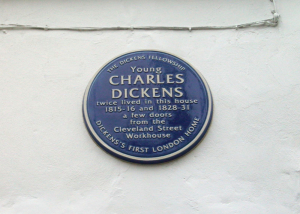Plaque unveiled to identify Charles Dickens first London home

Dan Calinescu who sponsored the plaque travelled from Toronto to be at the ceremony.
By News Reporters
The house at 22 Cleveland Street has long been known as Charles Dickens first London home but it was not until this weekend — 143 years after the author’s death — that it finally gained a plaque to publicly identify it.
The lack of any notice on the building had caused confusion for at least one historian.
Confusion no more, for on Saturday 8 June around 100 people gathered at 5.30pm to see the plaque unveiled by Dickens’ great great great grand-daughter, Lucinda Dickens Hawksley.
Also present was Dan Calinescu the sponsor of the plaque who had travelled from Toronto for the ceremony, and Dr Ruth Richardson the historian who last year published a book on Dickens’ life in the house.

Charles Dickens lived at 22 Cleveland Street (formerly 10 Norfolk Street) 1815-16 and 1828-31.
It was Dr Richardson’s work that led to the blue plaque being placed on the building. In 2010 she became involved with a campaign to get the former Georgian and Victorian workhouse in Cleveland Street protected as a listed building and save it from demolition.
Dr Ruth Richardson had previously co-authored a paper on Joseph Rogers, a Poor Law medical officer who was employed inside the Strand Union Workhouse on Cleveland Street and it was because of this she was asked to join the campaign.
During her research she stumbled upon the fact that Charles Dickens had actually lived just a few doors down from this very workhouse. She remarked: “I nearly fell off my chair in the Library!”
After further research she argued that it was probably the inspiration for his most famous novel, Oliver Twist. As a result the former Strand Union Workhouse in Cleveland Street received listed status.
In 2012 she published a book Dickens and the Workhouse. In it Richardson recounts how she made the discovery by checking old maps of London and realising that when biographers of Dickens had referred to 10 Norfolk Street it was actually the same building as today’s 22 Cleveland Street. According to Richardson, because the building had no Blue Plaque and no other mark on it no-one knew that the building on the corner of Cleveland Street and Tottenham Street was Dickens former house.
But the checking of old maps was not necessary, because what Richardson did not know — and what much of the media coverage has ignored — is that several books had already been written mentioning the fact that Charles Dickens had lived at 22 Cleveland Street and that there was a workhouse in the street.
This was pointed out when Fitzrovia News reviewed the book and again when we challenged Dr Richardson and Oxford University Press.
Literary scholars may debate the merits of her argument that Oliver Twist was based on the Cleveland Street Workhouse, but Dr Richardson’s work has given new insights to the early life of Charles Dickens, and the plaque on 22 Cleveland Street will be viewed by many as a testament to this.
